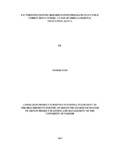| dc.description.abstract | Offenders are taken to the rehabilitation centers and schools for character reformation and eventual reintegration back to the society. The government of Kenya has established rehabilitation schools with the aim of correcting and reforming the delinquent adolescent into adjusted productive citizens. These rehabilitation centers have programs designed to meet this objectives, however, the ability of these schools to deliver the programs in a manner that is beneficial to this group of youths is questionable. The objective of this study will be to establish factors influencing achievement of Juvenile rehabilitation programs in juvenile correctional centers in Kakamega East Sub County, a case of Shikusa Borstal institution. The study will be guided by the following objectives; How psychosocial support, education and training, managerial skills and competence and juvenile support approaches influence the achievement of juvenile rehabilitation programs in Shikusa Borstal institution. Literature was reviewed from previous studies and journals. This study will adopt a descriptive research design that will be applicable in this study. Descriptive research designs attempts to describe the way the situations exist at the time of the study without manipulating the research conditions. That will aim to establish factors influencing rehabilitation programs in juvenile correctional centers. The Target population will be 150 members of staff and 350 juvenile offenders who will form the population from which a sample will be derived from. The collection technique included document analysis, questionnaires and interviews. The instruments were self-made. Piloting of the instrument that sought to ascertain validity of the instrument, reliability was assessed using test – retest reliability technique. The instrument was piloted twice to determine if the responses was consistence. Data was analyzed using descriptive statistics such as frequencies and percentage counts and presented using frequency and percentage tables and cross tabulations. Quantitative data was analyzed using Statistical Package for Social Sciences (SPSS) Version 17.0. Quantitative data was presented as guided by themes and objectives and reported in a narrative way, frequencies and percentage tables presented quantitative data while categorical responses on the dependent variable on the factors influencing the adoption of water, sanitation and hygiene practices were cross tabulated. Recommendations from the study will be useful to all stakeholders involved in the juvenile correctional and rehabilitation to enhance policy formulation towards effective rehabilitation programs in juvenile correctional centers. | en_US |



